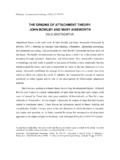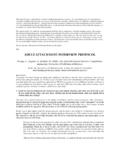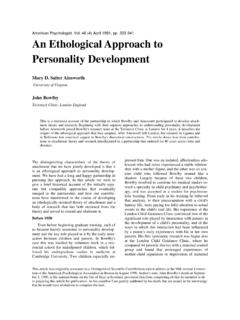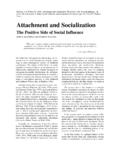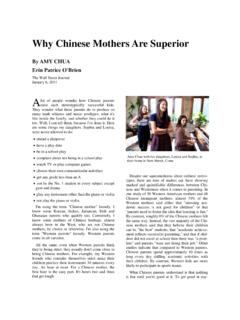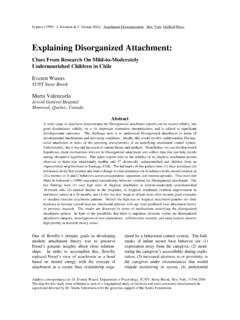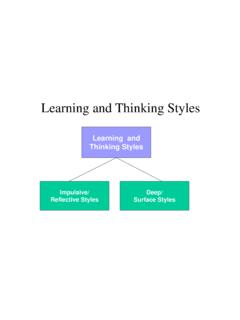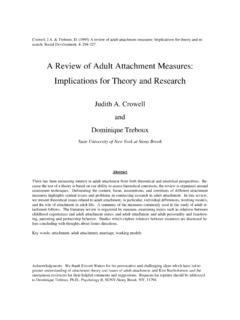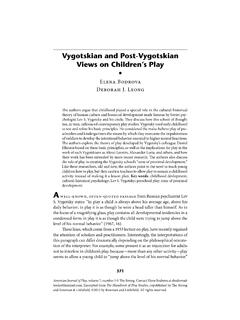Transcription of Vygotsky’s Theory - Stony Brook
1 Zone of proximal DevelopmentScaffolding: Teacher adjusts the level of support as performance and Thought:Develop independently of each other, then external or social origins Private Speech Vygotsky s TheoryZone of proximal DevelopmentUpper LimitLower LimitLevel of additional responsibility the child can accept with assistance of an able instructorLevel of problem solving reached on different tasks by the child working aloneAn Example of ScaffoldingScene: Mom is helping child construct a puzzle. They have a model that they can refer to. The child tries to place green pieces where they do not belong. Mom: Did we find any green up here? (points to model)Child: (looks at model) This one. (points to incorrect placein the model)Mom: I think maybe that s a leftover. Do you think so?Child: (nods)Mom: Maybe we don t need the green one, cause there isn tany green one up there, is there.
2 Remember? Child: (looks at pieces pile, puts green pieces back, chooses two appropriate s basic idea of language and thoughtLanguageThought~ 2 yearsPiaget Vygotskypresocial speechegocentric speechsocial speechsocialized speechprivate speechinner speechcommunicative speech Not specific enough about age-related changes There are potential pitfalls in collaboration and guidanceCriticisms of Vygotsky s TheoryVygotsky s Key ContributionEmphasizes the social contexts of learning, and that knowledge is mutually built and constructed Assess child s zone of proximal development Provide just enough assistance Use more skilled peers as teachers Encourage private speech, self-regulationOverall Teaching Recommendations - VygotskyCognitive and Language DevelopmentLanguage DevelopmentHow Language DevelopsWhat IsLanguage?)
3 Biological andEnvironmental InfluencesLanguage is ..PhonologySound system of a languageMorphologyUnits of meaning involved in word formationSyntaxRules for combining words into phrases/sentencesSemanticsMeaning of words and sentencesPragmaticsAppropriate use of language in different form of communication, spoken, written, or signed, that is based on a system of are neitherexclusivelybiological linguists norsocial architects of and Environmental InfluencesInteractionistsemphasize the contribution of both. Preschool: learn morphological rules like plurals, -edfor the past tense Preschool: learn and apply the rules of syntax, , how to form wh-questions Middle Childhood: vocabulary development continues at a breathtaking pace6 yr olds: 8,000 14,000 words12 yr olds: 50,000 wordsKey Milestones in Language Development Middle Childhood: Development of metalinguistic awareness knowledge of language, , what a preposition is Adolescence: Greater understanding of metaphors, satire, and complex literary works Adolescence: Writing improves as planning and revising skills are enhancedKey Milestones in Language DevelopmentSupporting Vocabulary DevelopmentIncrease opportunities for reading & writingComputers Relate the new to the known Promote active, in-depth processingEveryday conversations.
4 Introduce and elaborate on new wordsGive students an opportunity to use words in a variety of contexts STUDY IN VOCABULARY TRAINING4th to 6th grade students read the following passage with the difficult or the easy and Ann went to school in Portland. They were antagonists (enemies). They saw each other often. They had lots of altercations(fights). At the end of high school, Ann maligned(said bad things about) Joe. Then Ann moved away. Joe stayed in Portland. He got a job as abailiff(worked for a judge). One day Joe was working, and he saw Ann. Ann did not see Joe. Ann looked apprehensive(afraid). She was being incarcerated (under arrest). Students from both groups performed equally well on literal questions, but the students with the difficult words did much worse on inference IN VOCABULARY TRAININGS ample Test Questions Literal Questions such as: Joe and Ann saw each other _____ in school.
5 (a) never (b) not much(c) frequently(d) oftenInference Questions such as: Joe works in a _____ .(a) school (b) hospital(c) courthouse(d) university STUDY IN VOCABULARY TRAININGS ample of Training Format Experimenter:This word is altercations. What word is this?Child: Altercations. Experimenter: Correct, altercations. What does altercations mean? (points to meaning on index card).Child: Fights. Experimenter:Yes, altercations means fights. Listen do youhave altercations with your teacher? [child responds]Do you have altercations with a tree? [child responds].So what does altercations mean?Child: Fights. Experimenter: (after similar questions about antagonist )Listen,Do you have any antagonists [child responds]Do you have anyaltercations with your antagonists? [child responds]
